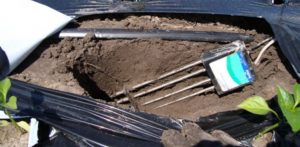
By Clint Thompson
Irrigation scheduling tools like soil moisture sensors can save vegetable growers valuable input costs by applying less irrigation while also increasing crop yields, according to University of Georgia (UGA) Cooperative Extension Vegetable Specialist Andre da Silva.
He discussed irrigation management in vegetables during the Georgia Plant Food Educational Society meeting on Jan. 14–15 on the UGA Tifton campus. His research involved zucchini, bell pepper and cabbage.
GREATER YIELD, LESS WATER
“What we have seen is an increase for bell pepper in about 11 percent on yield, and we have seen an increase in about 20 percent for squash and zucchini. What we are expecting is if our growers start using those tools, we can increase our production. We can also reduce our inputs of fertilizer because when you overirrigate, you’re moving your nutrients below the soil profile,” da Silva said. “But when you properly irrigate, that nutrient will be available, and you don’t need to catch up whatever was lost before in that next application.”
Soil moisture sensors are key irrigation tools for producers. They are stationed in different parts of fields to provide data, which lets the grower know how much moisture is in the soil and when and how much irrigation is needed. This allows growers to be more precise in their irrigation scheduling rather than just watering on a specific schedule.
“In our trials, what we have seen is when you properly manage or use soil moisture sensors, we have about 20 percent in water savings in bell pepper,” da Silva said. “On squash and zucchini, we are seeing similar numbers.” While the research trial is continuing with a second year, a definite increase in water savings has been seen so far.
SENSOR SELECTION
There is a plethora of soil moisture sensors available for vegetable growers based on their needs and budget.
“They can go as cheap as $50, where the growers need to go to the field and make the reading themselves, and it can go as high as $2,000 per sensor where the grower can access it from his phone … It’s going to depend on what the growers want to do or what the budget is,” da Silva said. He also noted that sandy soils require more sensors than clay soils.
According to da Silva, some vegetable farmers, like those who grow watermelons, bell pepper and tomato, still have time to decide on where and how many sensors to utilize for this upcoming spring crop.
“Different crops have different root systems. You need to identify where to install (the sensors),” da Silva said. “In the case of bell pepper, you have two rows going. You don’t want to put your sensor under the drip line; you want to put it under the plant line … For tomato, you want to put it under the drip line where your root system is. That’s one point where growers need to pay attention as they start planting.”









